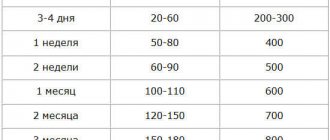Intestinal colic in newborns occurs in almost everyone; about 80-90% of mothers face this problem. But there is no need to panic about this; this is almost always a physiological phenomenon.
There are many means and methods that can be used to alleviate the child’s condition and reduce the frequency and duration of colic in infants.
Intestinal colic is a painful spasm of the muscles of the large intestine due to irritation or stretching of the intestinal wall by gases.
Causes of intestinal colic in newborns
Physiological colic occurs due to immaturity of the gastrointestinal tract in newborns. Neuromuscular regulation is still very poor. Enzyme systems are also still immature. All 9 months before the baby was born, his gastrointestinal tract did not work, the ingested water did not need to be digested in any way, and no enzymes were required.
After birth, the baby begins to feed on breast milk, the need for digestion appears, and enzymes begin to be produced to digest breast milk. In the first weeks of life, the newborn eats very small portions, so there may not be colic at first.
By the end of the first month of life, his needs increase, milk consumption becomes greater, but the enzyme systems are still immature and will remain so throughout the first year of life. Only by 6 months will the child begin to develop new enzymes, but the formation of this system takes a very long time. As a result, gas formation increases.
Incorrect breastfeeding and short feedings can also lead to colic. Some mothers listen to the “advice” of grandmothers who say that you should not hold your baby at the breast for a long time. This is a huge mistake.
- Firstly, with a short feeding, the baby receives only foremilk; it is very rich in carbohydrates, which leads to gas formation.
- Secondly, the child does not receive hind milk, which is much more nutritious and contains the maximum amount of not only fats and proteins, but also immunoglobulins.
- Thirdly, contact with the mother at this age is very important for the child, especially during the period of colic, because it relieves pain, calms the child, and the warmth from the mother’s body reduces spasms and reduces colic.
During the period of colic in a newborn’s stomach, increased gas formation occurs, which causes him great discomfort and severe pain, so it is during this period that it is so important for him to feel contact with his mother, because otherwise the child feels defenseless, and the best way to feel protection and care from his mother is get breasts.
Mom's anxiety
One of the factors contributing to the occurrence of colic is the psychological state of the mother. A woman who has recently given birth may experience stress associated with a large number of new responsibilities. Some people can’t cope and experience psychological discomfort, which is why women have unstable hormonal levels at this time. Under the influence of maternal hormones, the baby may also experience certain sensations, anxiety, restlessness, which can provoke physiological disorders, spasms and colic.
How does colic manifest in babies?
Colic in newborns has several symptoms, but the main one is crying.
There are many reasons for a newborn to cry, for example, hunger, a wet diaper, a teething (teeth can erupt at any age, there are cases of children being born with one tooth), fear, a desire to be with the mother, to play, and neurological diseases.
With colic, crying is characteristic; an attentive mother can distinguish whether the baby is crying from abdominal pain or from hunger. Crying with colic is sharp, loud, accompanied by pressing the legs towards the tummy.
The crying is constant, very loud, and begins abruptly, unexpectedly, sometimes soon after feeding; this type of crying indicates colic in a baby. When the pain passes, the child quickly calms down.
To the touch, the baby’s tummy is dense, swollen, gases can often pass in large quantities, after which the baby feels better and calms down.
Comfortable pose
It is very good to place the baby on the changing table before feeding and place your hands under his feet. The child will push away from them, strain - the gas will come out. You can also press the baby's legs to the tummy before feeding.
Among the poses that mothers of colicky babies consider “healing,” relaxed poses first.
Relaxed pose. The mother lies reclining (with a pillow under her back), the baby lies with his tummy on the mother. This makes it very convenient for him to attach himself correctly and grab the areola properly. By the way, if you have a strong oxytocin reflex, milk sprays like a fountain and the baby choke during feeding, this is also your option.
Pose "Under the arm." Mom is sitting on the sofa or chair. The child is positioned on the side of the mother, his legs are behind the mother’s back, the mother holds his head with her hand, as if holding it under her armpit.
Side pose. Try also the pose on your side, just make sure to maintain tummy-to-tummy contact.
Pose “In Mom’s Hand.” The good thing is that your baby’s mouth will be at the level of the nipple and you won’t need to reach for each other.
Legion-Media
AS FOR THE RULE “keep it upright after feeding”: if the baby is not asleep, hold it, if he is snoring at the breast, there is no need to wake him up.
How can I help my baby?
Every mother wants to ease the suffering of her baby during the period of colic in newborns. What to do to make colic less and less frequent? Below are all the main measures that help reduce their manifestation, but the main thing that a mother should know is that there is no need to panic, but to be patient, since severe colic in a baby will go away on its own by about 3 months.
So, if a newborn has colic, what treatment is needed? There are several main points that will help you with this problem.
Proper breastfeeding
- Allow your baby to nurse for as long as he wants, even if it takes a few hours. At his age, this is not only normal, but also necessary.
- Make sure your baby latch onto the breast correctly so that no air gets into the mouth. Otherwise, the baby will swallow it, thereby air will enter the lower parts of the gastrointestinal tract and cause painful intestinal spasms.
- Do not supplement with formula. You can always improve lactation, you don’t have to think that the baby doesn’t have enough milk, in 99% of cases these fears are unfounded (see what to do, how to increase lactation if the baby doesn’t have enough breast milk).
- Introducing formula into a child’s diet will only worsen the situation, since he does not have the enzymes to digest the cow’s protein that they contain. Any new type of food is a huge burden for a child’s intestines. But you can’t create this burden unless necessary (see why you can’t give cow’s milk to a child under one year old).
After feeding, hold the baby upright for 5-10 minutes. As a rule, the baby swallows a little air when feeding, it needs to come out so as not to get into the intestines. To do this, they raise the child to a vertical position, following the simple laws of physics, the air comes out through the child’s mouth.
When feeding from a bottle, much more air is swallowed, since not a single nipple has the same anatomical shape as a woman’s breast. When sucking, air enters the area of the corners of the lips. Therefore, you should not spend extra money on “anti-colic” bottles. In principle, such bottles cannot exist.
Dry heat
Heat helps relieve spasms, as it improves local blood circulation and causes muscle relaxation. It is best to use a warm diaper. It can be heated on a radiator or with a hot iron. Apply to the baby's tummy (be careful not to burn the baby's delicate skin). To keep the warmth longer and make the baby calmer, place it and the diaper on you.
Place the baby on his tummy and do gymnastics
Place your baby on his stomach as often as possible. Just do not do this immediately after feeding, as there is a high risk of regurgitation in this case. This will not only train the muscles of the back, neck, and anterior abdominal wall, but will also enhance intestinal motility, which means it will improve the passage of gases.
Massage
Massage for colic in infants has a very beneficial effect. This should be done before each feeding. This should be a massage, not a light stroking. Pressing firmly, you need to make circular movements in the tummy area clockwise. These movements should be done for 2-3 minutes. Then you can bend the baby's legs at the knees and press them to the tummy, this will facilitate the passage of gases. Repeat all these manipulations 2-3 times.
Diet
Everything you eat goes into your blood and from there into your milk. If the child is breastfed, then it is important to exclude a number of foods from the diet for the first 3-4 months. This will not save you from colic at all, but it will significantly ease the situation.
There are several foods that cause colic in newborns. These include:
- milk and dairy products
- legumes (peas, beans, lentils)
- White cabbage
- apples, especially green ones
- grapes, raisins, bananas
- yeast dough
Also, you should not overindulge in sweets. Many young mothers make the mistake of believing that milk will improve lactation, when it has no effect on lactation. Moreover, it causes very severe colic in the child, up to the appearance of foamy stools, and can also provoke allergies in the baby.
Herbal teas based on fennel and anise. Both mother and child can drink it if it is children's herbal tea without sugar and its substitutes.
If all of the above methods do not help prevent colic in a newborn, what should you do? Medicine should be given. Below we will discuss in detail the types of medications used for colic. You need to give one thing, you should not give everything from the list of medications at once. And before this, you should definitely contact your pediatrician so that all other causes of the child’s anxiety are excluded and the most suitable drug for the baby is selected.
Women's online magazine for lovely ladies
- Health
— 16.10.2017 16.10.2017 2 27710
Quite recently, the meaning of your life was born - a baby to whom you are ready to give all of yourself without a trace. For two weeks he regularly sucks the breast with appetite every two and a half, three hours, then sleeps. You devote all your time only to him - there is not a minute left for yourself. You admire every moment spent together, enjoy every little thing. Now he looked at you, now he smiled in his sleep, now he raised his legs and arms... Joy is darkened only when the child begins to cry.
The cause of crying may be colic in the baby.
Drug treatment
It is almost always necessary to prescribe medications for colic in infants. There are a very large number of them and they are all divided into several groups.
Simethicone preparationsThese drugs act on gas bubbles in the intestines. They allow them to merge, thereby facilitating the removal of gas naturally. Simethicone is not absorbed in the intestines. This group of drugs includes:
|
ProbioticsNewborns do not have “good” bacteria in their intestines, which are necessary for the normal functioning of the digestive system. Newborns receive most of them through mother's milk. But in order to speed up the colonization of the intestines with the necessary flora, on the recommendation of a doctor, you can give the child probiotics, but only in a certain course and dosage indicated by the doctor. These include:
For more details, see the list of probiotics - analogues of Linex. |
Preparations containing enzymesSince the baby’s enzyme systems are imperfect, medications with enzymes can relieve colic. These include Creon (used only as prescribed by a doctor). Lactazar is also used, this is a dietary supplement that helps break down lactose, it is used for lactase deficiency, it is a source of the lactase enzyme.
|
Herbal preparationsFennel and Anise have an anti-colic effect, they accelerate peristalsis and allow gases to be removed from the intestines faster, thereby easing the child’s condition. Among them are:
|
If you follow these simple rules, then the time when your newborn’s colic will go away will come very soon. Remember that colic is physiological, but you just need to ease the baby’s suffering. But almost every baby has them up to 3-4 months, you just need to get through this time, it will pass and all the difficulties will quickly be forgotten.
Author:
Revus Olesya Grigorievna, neurologist
Lactase deficiency
Another reason is lactase deficiency. Characterized by a lack of the enzyme lactase, which breaks down the milk sugar lactose. As a result, undigested sugar ferments and causes gas.
Lactase deficiency can cause colic, but is not the root cause of its occurrence in most children, since it is quite rare - approximately 1 case per 100,000 newborns. Lactase deficiency cannot be established by description alone. It is necessary to conduct an examination that will confirm or refute the diagnosis. Subsequently, the child is prescribed the necessary medications in combination with special mixtures, after which the attacks usually go away.











